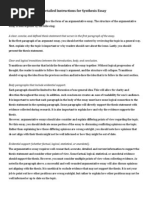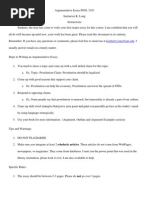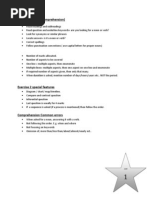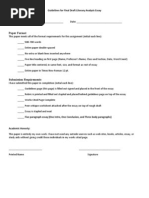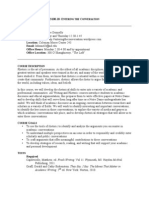Essay Skeleton: Privacy (Undercover Parent)
Essay Skeleton: Privacy (Undercover Parent)
Uploaded by
api-315626359Copyright:
Available Formats
Essay Skeleton: Privacy (Undercover Parent)
Essay Skeleton: Privacy (Undercover Parent)
Uploaded by
api-315626359Original Title
Copyright
Available Formats
Share this document
Did you find this document useful?
Is this content inappropriate?
Copyright:
Available Formats
Essay Skeleton: Privacy (Undercover Parent)
Essay Skeleton: Privacy (Undercover Parent)
Uploaded by
api-315626359Copyright:
Available Formats
Essay Skeleton: Privacy
(Undercover Parent)
ESSAY Requirements:
Essay Components:
Introduction ( Start with a statistic or well known documented fact,
background info (should include the two opposing perspectives on parent involvement in their
teens life), THESIS STATEMENT (argument)
3 body paragraphs
topic sentence that obviously connects to the thesis
relevant textual evidence with lead-ins, transitions, and sourcing
(parenthetical or embedded citations required)
thorough and insightful analysis (you can play around with the
S/M/M order if youre ready)
In the third body paragraph, you are required to show the
opposing viewpoint and be able to refute it with one of the three rhetorical fallacies.
Conclusion (revisit major claims, wrap up with an insightful/thoughtprovoking closer, so what? connection to our lives and our future.)
Works Cited page (we will create this together)
Writing Focus Areas (in order of importance):
Coherent organization (thesis topic sentences matters)
effective use of transitions and varied lead-ins
sufficient analysis (dont just stop at 1 matters if what you have to say isnt
finished)
absolutely NO sentence fragments or otherwise obvious errors in sentence
structure, spelling, capitalization, etc. Did I mention that this is SUMMATIVE? ;-)
varied sentence structure
appropriate word choice and concise language (diction)
The Nuts and Bolts
What specific components do I need to include?
*MLA (header, heading, double space)
*12 pt. Times New Roman/Blue or black ink
*must include a minimum of 9 separate pieces of quoted textual evidence
*3rd person (he, she, they, the people, society, an individual, etc. No I, Me, We)
*Dont announce anything! Let your analysis do the talking!
*all brainstorming and building blocks are completed on time (FA)
*meets submission deadline (SEVERE penalty for late submissions) to BOTH G. Classroom & Turnitin
THERE IS A MINIMUM AND A MAXIMUM REQUIREMENT: PAPERS SHOULD BE A MINIMUM OF THREE
COMPLETE PAGES AND SHOULD NOT EXCEED FIVE.
You will also need a works cited page that will be taught in class.
Writing Category Points:
Skeleton: FA 50 points
Rough Draft: FA 100 points (20 points per paragraph)
Final Draft: SA 250-300 points
Steps to Take (in this order!):
Notice the blue hyperlinks (more may be added as we go along).
TASKS TO KEEP YOU ON TRACK FOR SUCCESS!
DONE?
Thesis and Evidence
Tues 5/3
Work on introduction and tie in your thesis statement
Tues 5/3
Work on body paragraph 1 and 2
Wednesday
and Thursday
5/4
Lesson on body paragraph 3 and work and complete body 3 and conclusion.
Fri 5/6
submit your FINAL DRAFT Google doc by the deadline to Google Classroom AND
turnitin.com Sunday by 11:59
Sunday 5/8
Dissect the Prompt!
Italicize the action verbs, underline the what/main idea, highlight key terms.
To what extent should parents be involved in their teens life
Build an argument that supports or limits parents involvement in their teens life. Support your
position by providing reasons and examples from the readings and one outside source.
BODY PARAGRAPH TIPS
(Note: its about the balance, not necessarily the order. Play around with what weve learned recently. Take risks!)
Topic Sentence:
Clearly state the argument/claim that will be proven through your evidence & analysis. Think of this as a mini-thesis statement for
your paragraph. It MUST relate to your thesis!
Lead-In/Historical Context:
In English, a lead-in is usually a phrase or
clause that introduces the quote. In History, you
are required to have 1-2 sentences of relevant
historical background.
Says/TE/Evidence:
Direct quote from your provided source(s) that directly proves your argument made in
your topic sentence. Properly punctuated parenthetical citation is required.
Means/Analysis:
This is an interpretation or elaboration of what the quote means.
Matters/Significance:
Whats the significance? How does the evidence/quote prove your argument/topic sentence? Why is this quote important to the
essential question?
Transitional
Phrase/Sentence for
Lead-In/Historical
Context:
Use transitional phrase or
word to lead into your next
piece of textual evidence.
Lead-In/Historical Context:
In English, a lead-in is usually a phrase
or clause that introduces the quote. In
History, you are required to have 1-2
sentences of relevant historical
background.
Says/TE/Evidence:
Direct quote from your provided source(s) that directly proves your
argument made in your topic sentence. Properly punctuated
parenthetical citation is required.
Means/Analysis:
This is an interpretation or elaboration of what the quote means.
Matters/Significance:
Whats the significance? How does the evidence/quote prove your argument? Why is this quote important to the essential
question?
Concluding Statement:
Synthesize what you learned by writing a declarative statement that revisits your EQ(essential question)/thesis.
Last Stop: The Conclusion!
Remember, your conclusion sums up everything youve just said.
Were going to break it down into three parts...
Conclusion
COUNTER-ARGUMENT (Who might disagree with your statement?):
Although some people think ___________________________________________ because ____________,
____________
One can argue that ______________________________________ because ___________________________
REVISIT EVIDENCE (Bring it back to your side):
However, __________________________________________________________________
Nonetheless, _______________________________________________________________
The point remains, __________________________________________________________
It is essential to recognize ____________________________________________________
CALL TO ACTION (What should your reader consider, feel, do, etc. after
reading your essay?):
Readers should take away ____________________________________________________
One should acknowledge that _________________________________________________
You might also like
- Mildred PartenDocument15 pagesMildred PartenryemasonNo ratings yet
- Husserl - The Idea of A Philosophical Culture.Document10 pagesHusserl - The Idea of A Philosophical Culture.Philip Reynor Jr.No ratings yet
- Formulating Your Philosophy of EducationDocument10 pagesFormulating Your Philosophy of EducationRonelio Marabante100% (3)
- ENG 102 Essay PromptDocument2 pagesENG 102 Essay Promptarshia winNo ratings yet
- Essay Prompt and Task SpecificationsDocument4 pagesEssay Prompt and Task Specificationspelin.lal2705No ratings yet
- Evaluation Essay Instructions and RubricDocument6 pagesEvaluation Essay Instructions and Rubrictorr4727No ratings yet
- English III Research Paper AssignmentDocument5 pagesEnglish III Research Paper Assignmentapi-237740013No ratings yet
- Detailed Instructions and Schedule For Synthesis EssayDocument3 pagesDetailed Instructions and Schedule For Synthesis EssayelgoldenNo ratings yet
- 8af4b213 Db43 419b 8537 5ac0e33b55c2 Basic+Notes+of+History+Paper+1+National+Movements+and+New+States+in+Africa.Document331 pages8af4b213 Db43 419b 8537 5ac0e33b55c2 Basic+Notes+of+History+Paper+1+National+Movements+and+New+States+in+Africa.Akandwanaho FagilNo ratings yet
- Essay Skeleton: Privacy (Undercover Parent) : Essay Components THESIS STATEMENT (Argument 3 Body ParagraphsDocument5 pagesEssay Skeleton: Privacy (Undercover Parent) : Essay Components THESIS STATEMENT (Argument 3 Body Paragraphsapi-312906211No ratings yet
- AP English Language Synthesis Essay 2012Document6 pagesAP English Language Synthesis Essay 2012jadotuw1viv3100% (2)
- Argumentative Essay Instructions and RubricDocument4 pagesArgumentative Essay Instructions and RubrickdlongNo ratings yet
- The Topic Sentence and The Thesis Statement Are The Same ThingDocument5 pagesThe Topic Sentence and The Thesis Statement Are The Same Thinglisamoorewashington100% (1)
- Essay RubricDocument2 pagesEssay Rubricapi-260692414No ratings yet
- Peer Review: A3 Draft: PEER REVIEWS: Are Worth 15 Points Total For EACH ReviewDocument2 pagesPeer Review: A3 Draft: PEER REVIEWS: Are Worth 15 Points Total For EACH ReviewDerrick Kibui MwichingiNo ratings yet
- Essay Writing Tips For The TOEFLDocument3 pagesEssay Writing Tips For The TOEFLTeddy GeovanieNo ratings yet
- Thesis/Claim and Essential Questions: Essay Rubric Exceeds (4) Proficient (3) Emerging (2) Developing (1-0)Document2 pagesThesis/Claim and Essential Questions: Essay Rubric Exceeds (4) Proficient (3) Emerging (2) Developing (1-0)api-278321671No ratings yet
- AP Euro Writing PacketDocument32 pagesAP Euro Writing Packetjoero51No ratings yet
- English III Essay Rubric (11:14-Walz)Document2 pagesEnglish III Essay Rubric (11:14-Walz)api-130859276No ratings yet
- ExpozessayDocument2 pagesExpozessayapi-275159576No ratings yet
- How To Write A History Essay at CCADocument5 pagesHow To Write A History Essay at CCAlfhurlburt100% (1)
- Year 9 English Persuasive Writing Oral Presentation: What Is Required?Document4 pagesYear 9 English Persuasive Writing Oral Presentation: What Is Required?fajita_princessNo ratings yet
- Discussion Posts and Short Assignments - Eng21011-008 - Spring 2015Document4 pagesDiscussion Posts and Short Assignments - Eng21011-008 - Spring 2015api-280920003No ratings yet
- 2.basics Essay Thesis Abstract Outline StructuresDocument18 pages2.basics Essay Thesis Abstract Outline StructuresmugwovictorNo ratings yet
- Essay Rubric: Style & Format ThesisDocument1 pageEssay Rubric: Style & Format ThesisLee-Yoo Improgo Tan IIINo ratings yet
- Position Paper InfoDocument5 pagesPosition Paper InfoJustine FamularcanoNo ratings yet
- Topic and InstructionDocument3 pagesTopic and InstructionKristine Astorga-NgNo ratings yet
- TOEFL Essay UnitDocument5 pagesTOEFL Essay UnitfelahikhanNo ratings yet
- 3 Point Parallel Thesis StatementDocument4 pages3 Point Parallel Thesis Statementfjncb9rp100% (2)
- Research Paper Assignment - 2020Document4 pagesResearch Paper Assignment - 2020zahidsarfaraz1111No ratings yet
- 105argumentative Synthesis Fall 2016Document2 pages105argumentative Synthesis Fall 2016Aggrey SmartfieldNo ratings yet
- AP Language and Composition Synthesis Essay Prompt 2013Document5 pagesAP Language and Composition Synthesis Essay Prompt 2013lisaolivenorthlasvegas100% (2)
- Steps For Writing An A.P. U.S. History Timed EssayDocument10 pagesSteps For Writing An A.P. U.S. History Timed EssayMary Kelly FriedmanNo ratings yet
- Course CompetenciesDocument6 pagesCourse CompetenciesKatieNo ratings yet
- Elements of An Essay Thesis StatementDocument8 pagesElements of An Essay Thesis Statementfjf1y2rz100% (2)
- Engagement Points GuideDocument4 pagesEngagement Points GuideavduongNo ratings yet
- Argumentative Essay RubricDocument2 pagesArgumentative Essay Rubricapi-341062913No ratings yet
- Exercise 1 and 2 (Comprehension)Document6 pagesExercise 1 and 2 (Comprehension)AyeshathNo ratings yet
- Essay Packet Lit AnalysisDocument4 pagesEssay Packet Lit Analysiselizabeth_lenherrNo ratings yet
- Assessment Brief Assignment 1Document4 pagesAssessment Brief Assignment 1Yvonne IoanaNo ratings yet
- Checklist For Revising Your Research Paper Draft: 2 The BodyDocument2 pagesChecklist For Revising Your Research Paper Draft: 2 The Bodyerfan reikiNo ratings yet
- Riting and Hetoric Ntering The Onversation: Academic Writing. 2Document6 pagesRiting and Hetoric Ntering The Onversation: Academic Writing. 2karaleedonnellyNo ratings yet
- Essay Writing TipsDocument5 pagesEssay Writing Tipsapi-208178797No ratings yet
- Overview of Essay PDFDocument9 pagesOverview of Essay PDFFadli SuandiNo ratings yet
- English Composition 1Document6 pagesEnglish Composition 1Jess Arceo100% (1)
- Term Paper GuideDocument8 pagesTerm Paper Guideapi-306755959No ratings yet
- Cum Sa Elaborezi Un Eseu ProfiDocument11 pagesCum Sa Elaborezi Un Eseu ProfiSarah WallaceNo ratings yet
- Peer Review Sheet-AnalysisDocument2 pagesPeer Review Sheet-Analysismfromskz2No ratings yet
- AP World History Writing GuideDocument7 pagesAP World History Writing GuideAP Stats BoyNo ratings yet
- TP Topics and RequirementsDocument13 pagesTP Topics and RequirementsKL ChanNo ratings yet
- YourdocumentDocument6 pagesYourdocumentAustin GomesNo ratings yet
- Faculty of Education Graduate Studies ProgramDocument5 pagesFaculty of Education Graduate Studies Programapi-528144614No ratings yet
- Persuasive Essay Editing ChecklistDocument2 pagesPersuasive Essay Editing ChecklistDarshan M MNo ratings yet
- IELTS Writing TipsDocument12 pagesIELTS Writing TipsAsmiNo ratings yet
- Tolmanrubric FaithlynnDocument2 pagesTolmanrubric Faithlynnapi-281836221No ratings yet
- 560 - 01 - Research Paper Due Dates-1Document2 pages560 - 01 - Research Paper Due Dates-1VaniaNo ratings yet
- How Do I Write A Thesis Statement For A DBQDocument7 pagesHow Do I Write A Thesis Statement For A DBQveronicasmithlittlerock100% (1)
- Thesis One or Two SentencesDocument5 pagesThesis One or Two Sentencesaprilbellhartford100% (2)
- FCE - Write An Essay B2Document4 pagesFCE - Write An Essay B2EstherNo ratings yet
- point-evidence-example-single-use-plastic-bags-direct-method-activities-grammar-drills_146018_1Document7 pagespoint-evidence-example-single-use-plastic-bags-direct-method-activities-grammar-drills_146018_1norakanaan2015No ratings yet
- Quarter 1 Final Essay Assessment English 11Document5 pagesQuarter 1 Final Essay Assessment English 11api-293165455No ratings yet
- Example Thesis Statement and Topic SentencesDocument4 pagesExample Thesis Statement and Topic Sentencesfc2b5myj100% (2)
- Precetation About Procedure TextDocument13 pagesPrecetation About Procedure Textifidt wwhNo ratings yet
- Innovation As A Learning ProcessDocument33 pagesInnovation As A Learning ProcessJorge MoralesNo ratings yet
- Development Across LifespanDocument6 pagesDevelopment Across Lifespanraprap100% (1)
- Nterviewing: GRIT: That's What Employers Are Looking For!Document10 pagesNterviewing: GRIT: That's What Employers Are Looking For!lopaz777No ratings yet
- Comic ReliefDocument10 pagesComic Reliefapi-297084375No ratings yet
- Does Morality Vary From One Culture To AnotherDocument2 pagesDoes Morality Vary From One Culture To AnotherJett rebibeNo ratings yet
- Term Paper On: The Heidelberg Tactile Vision Substitution SystemDocument17 pagesTerm Paper On: The Heidelberg Tactile Vision Substitution System10907659No ratings yet
- Guidance 1 Lesson 1Document5 pagesGuidance 1 Lesson 1jesrel olgueraNo ratings yet
- Data Flow Diagram - Online Job Portal: R. Sathish Prabhu (2018272040)Document3 pagesData Flow Diagram - Online Job Portal: R. Sathish Prabhu (2018272040)Sathish PrabhuNo ratings yet
- Daily Lesson Plan Year 5 - 2Document5 pagesDaily Lesson Plan Year 5 - 2Sara Vanan100% (1)
- Budget of Work: Reading and Writing Academic/Humms Second SemesterDocument3 pagesBudget of Work: Reading and Writing Academic/Humms Second SemesterkydgecruzNo ratings yet
- Clasificación PsicologiaDocument723 pagesClasificación PsicologiachilensiNo ratings yet
- Lesson 11 Fola 001Document9 pagesLesson 11 Fola 001Arvilyn ArabellaNo ratings yet
- 4th Year Make Up TestDocument2 pages4th Year Make Up TestAvegail ConstantinoNo ratings yet
- Cognitive Behaviour Therapy With Children Who StutterDocument10 pagesCognitive Behaviour Therapy With Children Who StutterMaria RomeroNo ratings yet
- Proficiency Level Descriptors...Document7 pagesProficiency Level Descriptors...rabel esparagozaNo ratings yet
- 7 Habits of Happy KidsDocument19 pages7 Habits of Happy KidsIsraa AdelNo ratings yet
- Skimming and Scanning Are Both Rapid Reading Technique1Document2 pagesSkimming and Scanning Are Both Rapid Reading Technique1Nora Abu BakarNo ratings yet
- So What Is PhilosophyDocument4 pagesSo What Is PhilosophySean IbascoNo ratings yet
- Topic 6Document3 pagesTopic 6Margie JavierNo ratings yet
- Recruitment & Selection TASKSDocument6 pagesRecruitment & Selection TASKSMarcus McGowanNo ratings yet
- ReadingDocument45 pagesReadingAngel FiloteoNo ratings yet
- Sex Positions A Beginner's Guide To Sex Positions For Incredible Couple's Experiences, Boost Your Sexual Energy and Become A Master of Kamasutra With Secret Techniques For Men and WomenDocument116 pagesSex Positions A Beginner's Guide To Sex Positions For Incredible Couple's Experiences, Boost Your Sexual Energy and Become A Master of Kamasutra With Secret Techniques For Men and WomenDrBishnu Prasad Mahala100% (2)
- RAG Slide ENGDocument41 pagesRAG Slide ENGWellcareNo ratings yet
- Lesson 4 - Subordinate ClauseDocument5 pagesLesson 4 - Subordinate ClauseFie ZainNo ratings yet
- Jorge Luis Borges Once Wrote That To Live in A Time of Great Peril and Promise Is To Experience Both Tragedy and ComedyDocument4 pagesJorge Luis Borges Once Wrote That To Live in A Time of Great Peril and Promise Is To Experience Both Tragedy and ComedyBách Hợp0% (1)
- Educ 4Document19 pagesEduc 4Fiona Medalla AngelesNo ratings yet







